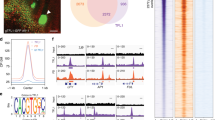Abstract
The spatio-temporal production of flowers is key to determining reproductive fitness in most flowering plants and yield in many crop species, but the mechanisms regulating this ‘reproductive architecture’ are poorly characterized. Here, we show that in members of the Brassicaceae, total flower number is largely independent of inflorescence number and that the proportion of flowers initiated on the secondary inflorescences represents ~50% of total floral production, irrespective of secondary inflorescence number. This ‘50% rule’ acts as a coordinating principle for reproductive development in Brassicaceae, and similar principles may operate in other species. Our findings suggest that inflorescences continue to compete with each other for a fixed pool of meristematic potential after their activation.


Similar content being viewed by others
Data availability
All data associated with this study are presented in the figures. Data are available on request without restriction from the corresponding author.
References
Domagalska, M. A. & Leyser, O. Nat. Rev. Mol. Cell Biol. 12, 211–221 (2011).
Walker, C. H. & Bennett, T. Annu. Plant Rev. Online 1, 1–38 (2018).
Seale, M., Bennett, T. & Leyser, O. Development 144, 1661–1673 (2017).
Prusinkiewicz, P. et al. Proc. Natl Acad. Sci. USA 106, 17431–17436 (2009).
Shinohara, N., Taylor, C. & Leyser, O. PLoS Biol. 11, e1001474 (2013).
Bennett, T., Hines, G. & Leyser, O. Trends Genet. 30, 41–48 (2014).
Aguilar-Martínez, J. A., Poza-Carrión, C. & Cubas, P. Plant Cell 19, 458–472 (2007).
Waters, M. T. et al. Development 139, 1285–1295 (2012).
Soundappan, I. et al. Plant Cell 11, 3143–3159 (2015).
Müller, D. et al. Plant J. 82, 874–886 (2015).
Waldie, T. & Leyser, O. Plant Physiol. 177, 803–818 (2018).
Feng, S. et al. Nature 451, 475–479 (2008).
Koornneef, M. et al. Physiol. Plantarum 65, 33–39 (1985).
Acknowledgements
The C. hirsuta seeds were the kind gift of A. Hay, and the C. rubella and C. grandiflora seeds were the kind gift of M. Lenhard.
Author information
Authors and Affiliations
Contributions
C.H.W. and T.B. designed and performed experiments, collected and analysed data and wrote the manuscript.
Corresponding author
Additional information
Publisher’s note: Springer Nature remains neutral with regard to jurisdictional claims in published maps and institutional affiliations.
Supplementary information
Supplementary Information
Supplementary Fig. 1 and Supplementary Tables 1–2.
Rights and permissions
About this article
Cite this article
Walker, C.H., Bennett, T. A distributive ‘50% rule’ determines floral initiation rates in the Brassicaceae. Nat. Plants 5, 940–943 (2019). https://doi.org/10.1038/s41477-019-0503-z
Received:
Accepted:
Published:
Issue Date:
DOI: https://doi.org/10.1038/s41477-019-0503-z
- Springer Nature Limited





